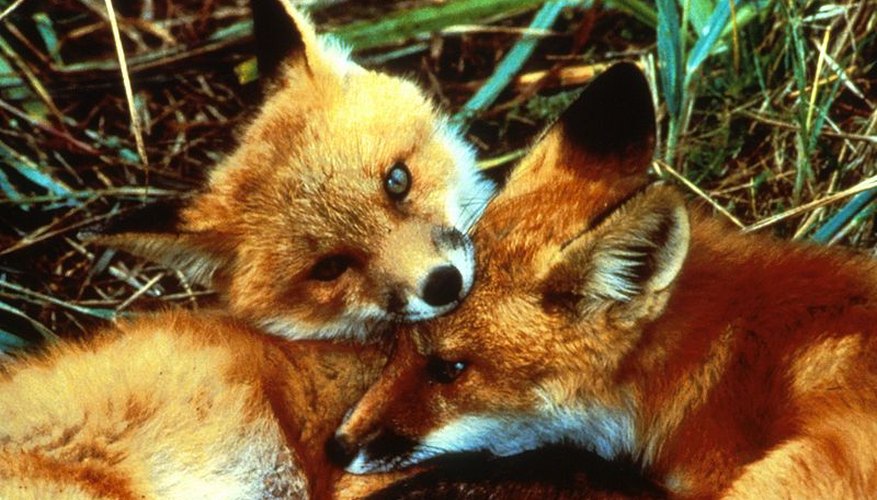Even as civilisation expands into the wooded areas, humans come into contact with the native animals more and more frequently. Understanding what some animals need to survive may help humans preserve some of the balance that is tipped when woodland areas begin to get destroyed. Saving a handful of trees, a stream or a pond might mean the difference between starvation and prosperity for some of the woodland creatures in which we share our world.
Red fox
Keep an eye out for these strikingly beautiful creatures with their distinctive red fur. They're common throughout wooded areas in North America and have even been introduced in areas of Europe and Asia where, thanks to the wide range of foods they eat, they are easily adaptable to different surroundings. During the spring and summer months, red fox supplement their diet with berries, wild fruit and grasses. From a young age, fox kits are also taught to hunt by mothers who bring them live prey practice on. This prey can include mammals such as rabbits and mice, but also insects like caterpillars, beetles and crickets.
- Keep an eye out for these strikingly beautiful creatures with their distinctive red fur.
- During the spring and summer months, red fox supplement their diet with berries, wild fruit and grasses.
White-tailed deer
If you're noticing trees and shrubs being stripped of their bark in the winter months, chances are it's a white-tailed deer. A unique, four-chambered digestive system lets the white-tailed deer eat branches and tree bark that most other animals would find inedible, an adaptation that helps them get through long winter months in their wooded habitats. The foods that they consume during the other seasons--grasses, flowers, nuts, and even vegetables--are scarce or non-existent in the cold, snowy winter, and there's little competition for the tree bark.
Raccoon
If you have woods, chances are you have raccoons, so keep an eye out for these curious, intelligent creatures. Raccoons have a varied diet that allows them to be extremely adaptable to their surroundings. They eat anything from nuts and berries to small shellfish, crayfish and even human food. They're often seen as resourceful, digging through garbage and even campsites to find some tasty morsels. For a long time, it was thought that their habit of submerging their food in nearby streams and lakes was a way to wash it, but now it's thought that they are simply softening it to make it easier to eat.
- If you have woods, chances are you have raccoons, so keep an eye out for these curious, intelligent creatures.
Great Horned Owl
Sitting outside after dark is the best time to hear these distinctive looking birds. Their mottled colouring helps them to blend in with the forests that they call their home, and their nocturnal tendencies ensure that they're most commonly out hunting at night. The Great Horned Owl is a fierce hunter, ripping its prey into pieces and swallowing it whole, later regurgitating indigestible fragments such as bones. Common prey for the owl are mammals such as mice, rabbits and even skunks, as well as other birds.
- Sitting outside after dark is the best time to hear these distinctive looking birds.
- Common prey for the owl are mammals such as mice, rabbits and even skunks, as well as other birds.
Chipmunks
Listen for the movement of a small animal that's there one moment and gone the next--chances are, you were just visited by a chipmunk. Small, quick and amazingly agile, these little creatures have perhaps one of the most surprising of diets. While they do eat nuts, acorns, berries and seeds, they also eat insects and even small mammals such as mice. They've also been known to raid birds' nests for the eggs, making them a surprisingly resourceful omnivore.
- Listen for the movement of a small animal that's there one moment and gone the next--chances are, you were just visited by a chipmunk.
- They've also been known to raid birds' nests for the eggs, making them a surprisingly resourceful omnivore.
Mink
The mink is a little more difficult to spot, nomadic animals who make their always temporary homes in wooded areas near water. Minks are carnivores, and kill mammals such as rabbits, chipmunks and squirrels while hunting on land, and animals such as fish, frogs and snakes while in the water. They have a unique method of hunting; the killing blow is delivered to the back of the prey's neck.
Black bear
Keep an eye out for these resourceful creatures as well, another one of nature's rogue that has adapted quite well to consuming--and stealing--food from humans. The black bear is an omnivore, and most of the bear's diet is made up of plants, twigs, berries and even honey. It's supplemented with grubs and insects as well as small mammals and fish. The black bear is extremely creative in hunting methods, experts at opening decaying logs to get at the grubs as well as expert fishermen.
- Keep an eye out for these resourceful creatures as well, another one of nature's rogue that has adapted quite well to consuming--and stealing--food from humans.
- The black bear is extremely creative in hunting methods, experts at opening decaying logs to get at the grubs as well as expert fishermen.
